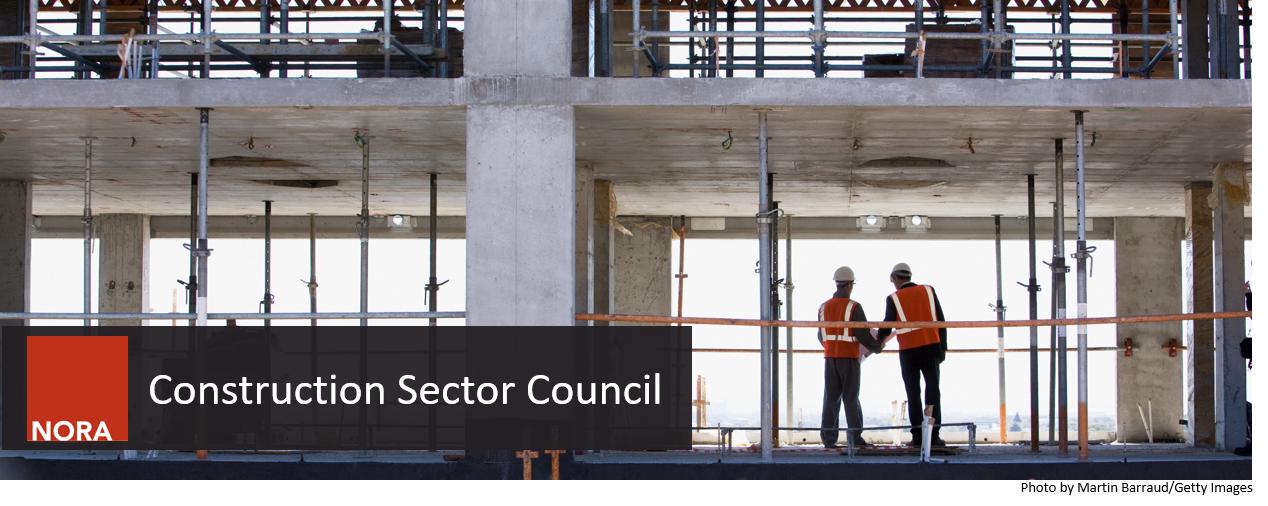NORA Construction Sector Council

The NORA Construction Sector Council brings together individuals and organizations with a shared interest in improving the safety and health of construction workers. Construction Sector Council members share information, form partnerships, and promote adoption and dissemination of solutions that work. The council meets twice a year for presentations and discussion. It also has two workgroups that focus on:
- Preventing falls through the annual National Campaign to Prevent Falls in Construction
- Preventing struck-by injuries/fatalities through the annual National Stand-Down to Prevent Struck-by Incidents in Construction
Contact the sector coordinator or NORA Coordinator to volunteer.
Outreach
Preventing falls
The National Campaign to Prevent Falls in Construction and the National Safety Stand-Down to Prevent Falls in Construction is held the first week of May each year. The goal of this national campaign is to prevent fatal falls from roofs, ladders, and scaffolds among residential construction contractors. s.
This event began in the Construction Sector Council in 2012. NIOSH, OSHA and CPWR-The Center for Construction Research and Training are the main partners working to coordinate the National Campaign and Stand-Down. The National Campaign and Stand-Down have reached millions of construction workers.
Each year, the NORA Construction Sector Council Falls Workgroup works with NIOSH and CPWR-The Center for Construction Research and Training to develop a new series of infographics in English and Spanish. View and download the infographics as PDFs or JPEGs for use in social media, presentations, and print materials. The Workgroup also helped with pulling together some of fall-related videos posted on the CDC Construction Safety and Health YouTube Playlist.
Preventing struck-by injuries
The Struck-by Workgroup organizes the National Stand-Down to Prevent Struck-by Incidents in Construction each year. This event is held in mid-April each year during Work Zone Awareness Week. The Stand-Down asks contractors to pause work to recognize that struck-by incidents are the #1 cause of injuries and #2 cause of death among construction workers. It’s also an opportunity to for contractors to educate their crews about risks and solutions. More information on ways to participate are posted on CPWR’s Struck-by Hazards webpage and the National Work Zone Safety Information Clearinghouse.
Research Agenda
The NORA Construction Sector Council identified research priorities for the third decade of NORA (2016-2026) in the National Occupational Research Agenda for Construction. The agenda identifies 16 research objectives for the nation.
Research objectives in the National Research Agenda for Construction:
- Falls from heights – Eliminate falls in construction
- Falls from same level – Significantly reduce or eliminate slips, trips, and falls
- Struck by – Reduce fatal and serious injuries associated with struck-by incidents associated with objects, vehicles, and collapsing materials and structures in construction
- Electrical – Conduct research to address electrical safety issues on construction sites
- Respiratory and dermal – Reduce the frequency of occupational disease caused by respiratory and dermal hazards in construction
- Hearing loss – Reduce occupational hearing loss in construction through a multifaceted research and outreach effort
- Musculoskeletal disorders – Reduce the risk and burden of musculoskeletal disorders (MSDs) in construction
- Workers at disproportionate risk – Conduct research to eliminate disproportionate risks in construction
- Small business – Reduce the number of illnesses, injuries, and fatalities occurring in small construction firms (employing 20 or fewer employees)
- Emerging issues
- Extreme temperatures – Reduce the likelihood of temperature extreme incidents in in construction and develop intervention strategies to protect these workers
- Prevention through Design (PtD) – Increase the use of PtD approaches to prevent or reduce safety and health hazards in construction
- Research to Practice (r2p) – Build capacity for and a body of research on effective translation research and r2p strategies to advance the use of evidence-based interventions in construction
- Work organization – Improve conditions in construction by studying safety culture and safety climate and how work is organized
- Surveillance – Reduce occupational safety and health hazards in construction through proactive surveillance activities and research
- Training – Research to increase the reach, scope, and effectiveness of training in construction
Sector Description
The construction sector has 11.8 million workers, and about 30% are of Hispanic origin. Small businesses are very common in this industry. Most construction establishments have less than 20 employees. The construction industry includes all jobs under North American Industry Classification System (NAICS) code 23. It includes not only residential and commercial building construction, but also heavy and civil engineering construction, like water and sewer lines, highways, and bridges. Specialty trades like roofing, plumbing, electrical, drywall, and painting are also included in the construction sector. Construction jobs are some of the most dangerous. Falls are the leading cause of death in the construction sector.
The construction industry can be difficult to study because of its complexity. It has a diverse set job tasks and employers, a high prevalence of small businesses, and variations in workforce skills, weather conditions, and work environments. Many construction projects are characterized by temporary and transitory work. A typical construction workplace changes daily, and the type of work varies greatly. It ranges from new construction, to repairs or renovations, to demolition to cleanup and reconstruction. One of the challenges that the restructuring of work practices cannot be accomplished in individual workplaces or with individual workers. Turnover of workers is relatively high. Construction workers are employed by many contractors during their lifetimes.
The NIOSH Construction Program facilitates the work of the Council and coordinates NIOSH research in this sector. NIOSH also hosts a Directory of Construction Resources.